This post may contain references or links to products from one or more partners of our parent company and/or subsidiaries of our parent company. For more information, visit this page.
Updated January 6, 2023
You’ve weighed the pros and cons of hardwood, and you’ve decided that you need some beautiful wood floors—but not just any types of wood flooring will do. You need the most durable wood flooring around.
Maybe you have kids; maybe you have overactive animals; maybe they’re one and the same (if so, we sympathize). Whatever the case, your hardwood floors need to stand up to abuse for years to come. So where do you go from here? How do you find out which wood species are the most durable?
Rest easy, friend—we’re here to help. In this guide, we’re going to walk you through everything you need to know to choose the most durable wood flooring.
We’re going to talk engineered vs. solid wood; we’re going to talk about the Janka Hardness Scale; we’re going to talk about finish options. Then, we’re going to show you our 13 picks for most durable wood flooring.
👉 For those of you that are simply looking for the best wood flooring brands, there are a clear top 3.
- Proximity Mills has revolutionary waterproof hardwoods that have been the most popular hardwoods of 2023.
- Newton has some of the best priced hardwoods on the market.
- Paradiso has the most beautiful luxury hardwoods and they are not as expensive as you would think.
Which is More Durable: Solid or Engineered Hardwood Flooring?
The first question to ask yourself when looking at hardwood flooring is whether you want engineered or solid wood. You probably know the difference already, but if not, here’s how it breaks down:
- Solid wood flooring is made of a single piece of wood throughout. For installation purposes, it’s usually nailed, glued, or stapled to a subfloor.
- Engineered wood flooring is made of two parts: a plywood or fiberboard base layer with a thin veneer of solid hardwood on top. Engineered wood is often (incorrectly) thought of as fake wood flooring, but there’s nothing fake about it. It’s simply a different wood flooring type.
Most companies specialize in one or the other, but a handful of companies like Doma offer both engineered and solid wood flooring.
Engineered hardwood is less susceptible to environmental changes
If you’re looking for a hardwood floor that can stand up to big swings in temperature, moisture, or humidity, engineered hardwood is probably going to be your best bet. Unlike solid hardwood, which can warp and swell with these changes, engineered hardwood stays in place.
Paradiso is a luxury brand that actually combines certain aspects of solid and engineered hardwood flooring. They make wood flooring the old-fashioned way, with super-thick wood veneers and a long-lasting natural oil finish, plus the added dimensional stability of a high-strength core.
But remember: while engineered hardwood might be the most durable wood flooring when it comes to environmental changes, it is not necessarily water-resistant wood flooring. For that, you’d be better off going with a specialty product like Mohawk’s RevWood or comparing the pros and cons of tile vs. laminate flooring.
But solid hardwood can be refinished almost indefinitely
If for you, durability is the same as longevity, then solid wood is going to be the most durable wood flooring. Why? It can be refinished almost indefinitely! Even the best engineered wood flooring options can only be refinished a couple of times (at most) due to the thinness of the veneer.
This is by far one of the biggest engineered wood disadvantages there is, though most products purchased from the best engineered wood flooring brands can be refinished at least once.
Engineered wood can be cheaper to install
When it comes to the solid vs. engineered wood debate, we have to mention price. And it’s true—the cost to install engineered wood floors is often less than the cost to install solid wood flooring. Here’s why.
- Harder, exotic wood species can be cheaper if you opt for engineered materials because they use less of that expensive, exotic wood!
- Engineered wood can come as click-together flooring, meaning you can install it as a floating floor. Floating setups are some of the easiest types of flooring to install—much more so than solid options, which need to be nailed, stapled, or glued to a subfloor.
- What is subflooring? It’s the surface under your finished floor—and if you opt for an engineered option, you don’t need to worry as much about it (since engineered wood is less susceptible to warping).
Best Brands of 2024
Engineered or Solid, a Wood Floor’s Durability Comes Down to 2 Things
Regardless of whether you go with engineered or solid wood, your floor’s surface-level durability—its resistance to dings, dents, and scratches—is going to come down to two things:
- Its wood species (the type of tree it comes from)
- Its finish (aka its stain and topcoat)
We’re going to talk about both of these aspects in detail below.
Using the Janka Scale to Find the Most Durable Wood Flooring
There are literally hundreds of wood flooring types to choose from. How do you know which species will make the most durable wood flooring?
Luckily, we have an industry-standard scale for measuring a wood’s hardness. Hardness is an indication of how well that wood will stand up to surface-level wear and tear. It’s called the Janka Hardness Scale. Fun name, right?
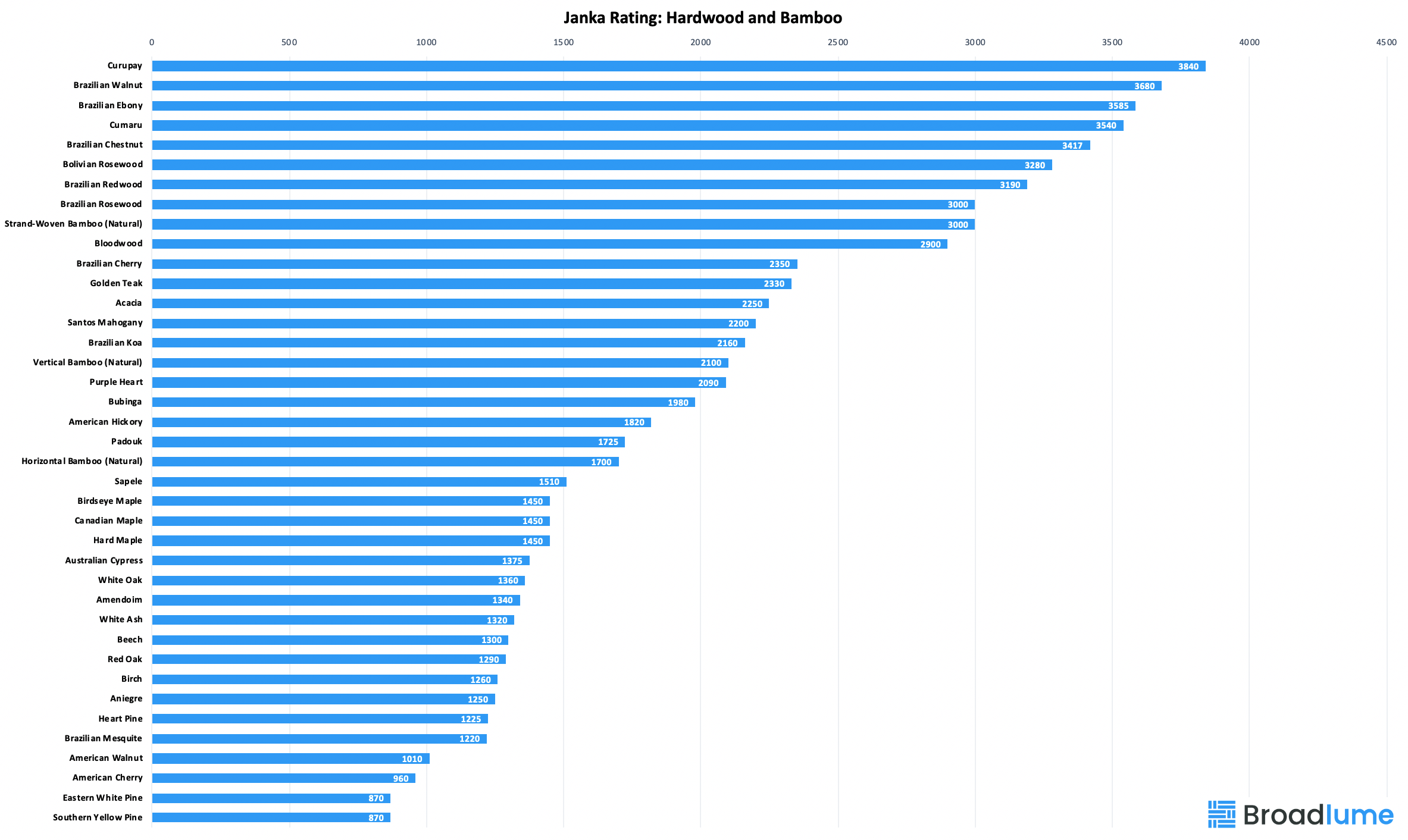
The Janka Scale measures the pounds of force needed to shove a steel ball halfway through a piece of wood. The higher Janka rating, the more durable the wood flooring.
Exotic woods tend to have the highest Janka rating. But of course, the higher you go on the Janka Hardness Scale, the higher your wood flooring cost is probably going to be.
The 13 Most Durable Wood Flooring Options
Now that you understand what the Janka Hardness Scale is, let’s get into the main event: our 13 picks for most durable wood flooring.
Just remember: these are our picks for the most durable hardwood species for flooring. They’re not necessarily the most durable wood species in the world, just some of the most durable ones used to make floors!
#1. Oak: The Industry Standard
When we talk about the Janka Scale, we often use oak as a reference point. That’s because oak is one of the most common wood flooring types in the US. And with its Janka rating around 1300 (White Oak rates at 1360 while Red Oak rates at 1290), it’s basically the middle ground when it comes to hardness.
That doesn’t mean it’s weak, though. Oak is the industry standard because it’s durable enough for anything! So when we talk about the most durable wood flooring, this is one of the best bets.
#2. Hickory: The Hardest American Wood Species
Hickory is the most durable wood species grown domestically with a Janka rating around 1820. So while there might be some disadvantages of hickory flooring, strength is not among them.
Hickory is a beautiful and unique wood species that sports various colors and a ton of grain character. It’s one of the best hardwood floors for buyers who want a durable surface and a lot of personality in their wood. Seriously—some of the most beautiful wood floor patterns use hickory to make them pop.
And generally, the pros and cons of hickory flooring come down to the fact that some people love its unique personality, while others don’t care for it.
#3. Santos Mahogany: An Exotic and Durable Wood
One of the most common exotic hardwood species for flooring, Santos mahogany is a super durable wood flooring option. Santos mahogany comes in around 2200 on the Janka scale and features a deep red color with a tight grain.
Woods like Santos mahogany are probably where you’ll go if you want something a bit harder than hickory. And pro tip: most “mahogany” floors are actually made of Santos mahogany!
#4. Maple: Contemporary and Shock-Absorbant
Maple flooring is commonly used for basketball courts because of its shock-absorbing properties. But it’s also quite strong with a Janka rating of 1450.
People love maple flooring for its creamy colors, light grains, and gorgeous finish—one reason it’s so popular in contemporary designs.
#5. Ebony: Very Rare, But Very Durable
Ebony flooring clocks in at a super-high 3220 on the Janka scale. But it’s not just hard—ebony is also the only wood in the world that’s jet black in appearance.
Unfortunately, these unique qualities make ebony a little too sought-after. In fact, the wood is threatened and extremely hard to come by in the amounts needed for flooring. To that end, most of the “ebony” floors you’ll commonly see are actually ebony-stained wood.
But if you can somehow come by ethically-sourced ebony, it is one of the most durable wood flooring options around.
#6. Teak: Water-Resistant and Glossy
Teak is an extremely durable wood flooring choice with a Janka rating of 2330. But if you look into teak flooring pros and cons, you’ll find that hardness isn’t the wood’s only selling point.
Imbued with tons of natural oils and resins, teak is extremely glossy and beautiful even without the use of finish. Additionally, these natural oils make teak a naturally water-resistant wood choice (one reason it’s often used on boats).
That said, teak may be a little too pricey to use as something like mudroom flooring. For that, we’d go with hardwood floor alternatives like vinyl plank. There are some disadvantages of vinyl plank flooring, but it’s almost always waterproof.
#7. Cumaru (Brazilian Teak): An Absurdly Durable Wood Flooring Choice
Cumaru, or Brazilian teak, sports a ridiculously high Janka rating of 3540. That alone would have earned it a spot on our list of the most durable wood flooring choices.
But Cumaru isn’t just absurdly strong and absolutely stunning. It’s also relatively inexpensive for an exotic import! That doesn’t mean it’s cheap, necessarily, but it can be less expensive than other super-hard exotic woods.
#8. Ash: Stylish and Hard
Ash flooring combines an excellent Janka rating of 1320 with a light, stylish grain that looks great in modern designs. Unfortunately, ash trees are currently threatened by a blight caused by the emerald ash borer beetle, so it may not be the most environmentally friendly flooring choice on this list.
#9. Jatoba (Brazilian Cherry): Durable and Resistant to Pests
On the other side of the coin, we have jatoba (sometimes known as Brazilian cherry)—which is, thankfully, resistant to termites and other pests. And it’s strong. Really strong. Jatoba has a Janka rating of 2350.
This makes jatoba a great choice for buyers looking for a strong, beautiful, and relatively sustainable wood flooring choice. Plus, jatoba’s beautiful reddish-brown grain is always a winner.
#10. Goncalo Alves (Tigerwood): Unique and Striking
Goncalo alves—also known as tigerwood—sports a 2250 on the Janka scale. So why is it called tigerwood? Because its amazing grain appears in stripes of alternating colors, just like the stripes of a Bengal tiger! Seriously, it’s beautiful.
#11. Bamboo: Hard and One-of-a-Kind
Ok, yes—bamboo is technically a grass—but since it looks and behaves just like hardwood flooring, we’re going to include it on this list. And that’s because strand-woven bamboo flooring can score well over 3000 on the Janka scale. That’s seriously hard.
Plus, bamboo’s many options—carbonized, uncarbonized, vertical, horizontal, strand-woven, etc.—make it a totally one-of-a-kind option. You can even buy engineered bamboo flooring! And take it from us, the pros and cons of engineered bamboo flooring are almost all pros.
#12. Hemp: Super New and Super Durable
Again, hemp isn’t technically a type of wood flooring, but it looks just like one and it ranks over 3500 on the Janka scale—so we had to include it.
Hemp flooring is one of the newest types of flooring around, as hemp has only been legal to grow in the US for industrial purposes since 2018. And while there are only one or two companies currently producing it, hemp rivals all of the most durable wood flooring choices around in terms of hardness and looks. Plus, it’s a super eco-friendly flooring option!
#13. Ipe (Brazilian Walnut): One of The Most Durable Wood Flooring Options Anywhere
If you’re looking for the most durable wood flooring there is, Brazilian walnut is going to be right near the top of the list. It’s not the hardest wood in the world, but as far as woods commonly used for flooring are concerned, it’s #1 with a whopping 3680 Janka rating.
Brazilian walnut boasts a deep color and a gorgeous grain. But remember: like a lot of exotic woods, Brazilian walnut has seen issues with illegal harvesting—so make sure to only buy Brazilian walnut from an FSC-certified retailer.
Which Styles of Wood Flooring Are the Most Durable?
If you’re looking for durable wood flooring, your two best bets are either:
- Waterproof wood flooring, which uses a water-tight finish layer and an engineered wood core to prevent swelling and water damage.
- High-density wood flooring, which is more resistant to compression (the true enemy of wood floors).
Both waterproof and high-density wood flooring are more dimensionally stable than solid wood, which means they can go where solid wood can’t. For a company that offers quality waterproof and high-density engineered wood flooring options, we recommend Proximity Mills.
Which Finishes Make for the Most Durable Wood Flooring?
As we mentioned before, a finish also affects your wood floor’s durability. How? Compare tile vs. wood floors. Wood can be purchased with or without a finish, and tile can be purchased with or without a glaze.
Glaze increases tile’s water-resistance, makes it harder, and decreases its porousness. And while not all types of floor tiles are glazed, the ones that are are generally more durable. And the same is true for a wood floor’s finish!
The Most Common Wood Floor Finishes
These days, a huge number of wood floors come pre-finished (especially at retail). That means you need to ask your flooring retailer about the durability of any finish you purchase. Some of the most common are:
- Oil-based polyurethane—One of the most common finishes (and one of the most durable).
- Water-based polyurethane—Another super-common finish, this one is a little less durable than its oil-based cousin. But it’s still a solid product!
- Lacquer // Shellac—Two more traditional finishes, these are often used in woodworking rather than on floors. That said, they’re beloved for their glossy shine, so you do you.
- Natural oils—If you’re going the natural oil route, keep in mind that you’re going to have to reapply your finish often if you want your floor to stay durable. That said, natural oils and hardwax can be extremely durable if maintained properly.
- Aluminum Oxide—This chemical can be found in many pre-finished floors, since it protects against scratches and UV fading. Make sure you ask if there’s aluminum oxide in your floor’s finish for maximum durability!
Bamboo and Laminate: The Two Most Durable Wood Flooring Options… That Aren’t Actually Wood
That’s right—two of your most durable wood flooring options aren’t even made of real wood! Bamboo and laminate both look like wood and behave like wood as far as installation and maintenance are concerned—but they’re not actually made from trees.
Bamboo is a ridiculously durable grass flooring
We mentioned bamboo a little earlier, but we want to go into a little more detail since there are so many options to choose from!
If you’re looking for types of flooring that are environmentally green and super, super durable, bamboo might be a great choice. You can read more about the differences in our guide to the best bamboo flooring types, but here’s the breakdown:
- Natural horizontal bamboo flooring has a Janka rating of 1700
- Natural vertical bamboo flooring has a Janka rating of 2100
- Natural strand-woven bamboo flooring has a Janka rating of 3000+
That’s right—natural strand-woven bamboo is almost 3 times as hard as oak, the industry standard. That’s the most durable wood flooring we can think of, really. And it’s not even real wood!
Laminate is an extremely durable composite flooring
You’ve probably come across laminate flooring in your research, but if not, here’s the scoop: laminate is a composite flooring product made out of three layers:
- A rigid composite base layer
- A photo-realistic image layer
- A durable plasticate wear layer
Basically, laminate can be made to look like absolutely anything thanks to its photo-realistic image layer. And more importantly, that plasticate wear layer is extremely durable. Laminate flooring was invented in the 1970s by Pergo, who still produces it today along with a bunch of other manufacturers (you can check out some Pergo and Pergo Extreme reviews here).
At the higher end of the price range, laminate can be even more durable than many wood flooring options. In fact, laminate’s only real competitor when it comes to durability is vinyl plank. Check out this comparison of vinyl plank vs. laminate flooring for more info on that!
Oh, and if low-VOC flooring is a priority for you, don’t worry—you can now find non-toxic laminate flooring options too!
Honorable mention: cork flooring
Though it’s not particularly hard (in fact, it’s quite flexible), the best cork flooring products are super durable. Cork’s bend makes it self-repairing to a certain degree—super, super important if you’re dealing with paw gouges or an overactive child.
Are there some disadvantages of cork flooring? Sure—but there aren’t many of them.
The Most Durable Wood Flooring for Dogs and Other Pets
Dogs are the best companions, but they can be a little rowdy (we’re looking at you, Jack Russell terriers). There are some dogs that’ll fetch you a drink and lay under your feet, while others will jump around, clawing at your delicate wood flooring. We speak from experience.
Finding the ideal type of wood flooring for dogs can be a challenge, as every wood can be dented and chipped. But if you paid attention above, you’ll remember that engineered wood can’t be refinished as much as solid wood can—if at all.
And since pet urine, scratch marks, and slobber can all wreak havoc on your floor, you may end up refinishing your wood floors more often than someone without pets. And that means solid wood could be the better choice for you.
Think about it this way: if this were a comparison between bamboo flooring vs. laminate or even laminate vs. hardwood floors, you’d most likely want to go with bamboo or hardwood. And that’s because you can refinish bamboo flooring and wood flooring, but you can’t refinish laminate.
Conclusion: The Most Durable Wood Flooring Depends on You
At the end of the day, the most durable wood flooring depends on you. Sure—if you’re judging based on the Janka Scale alone, strand-woven bamboo and Brazilian walnut are right near the top.
But we hope we’ve shown you that a wood floor’s durability depends on so much more than that! It depends on finish; it depends on whether it’s solid or engineered; it even depends on what “durability” means to you!
But there is one thing we can all agree on: you’re going to need an expert to help you find the best wood floors. Our advice? Use this flooring stores near me tool to find a local retailer in your area. They can help you with everything. And for more information on all things flooring, check out:
- A Guide to Peel-and-Stick Carpet Tiles (& 9 Reasons They’re Amazing)
- Carpet vs. Laminate: Which is the Right Floor for You?
- Do it Yourself Flooring: 5 Things you NEED to Know
- 9 Reasons The “Carpet vs. Hardwood” Debate is Silly
- Snap-Together Tile Flooring: A Total Game-Changer
- Advantages and Disadvantages of Floating Floors
- How to Replace Flooring: 8 Excellent Ideas
About The Author
Fredrick Otto Jr.
April 13, 2020
Fredrick is a writer that loves providing a good story. If he's not on his couch working, he can be found gaming in his man cave.
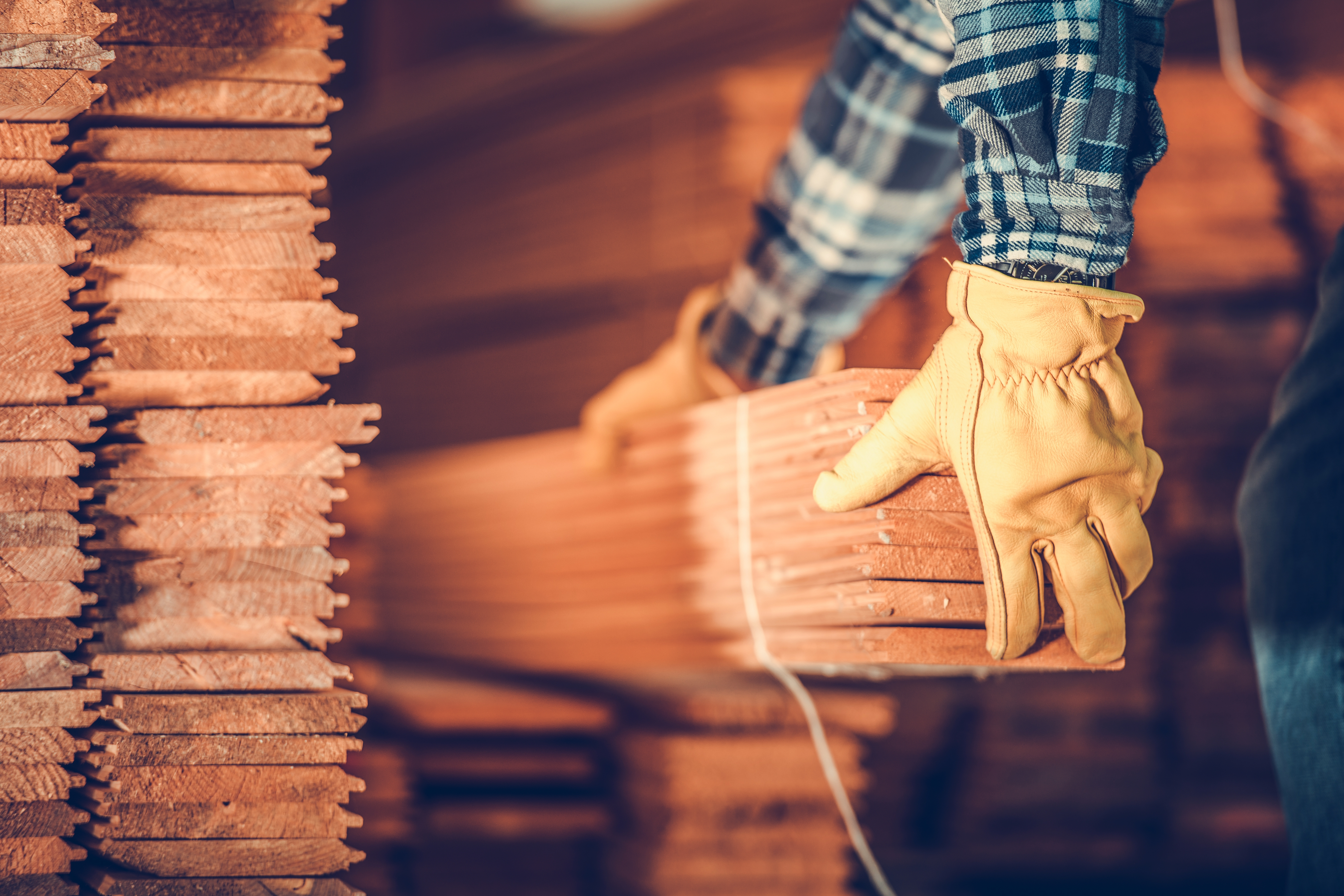
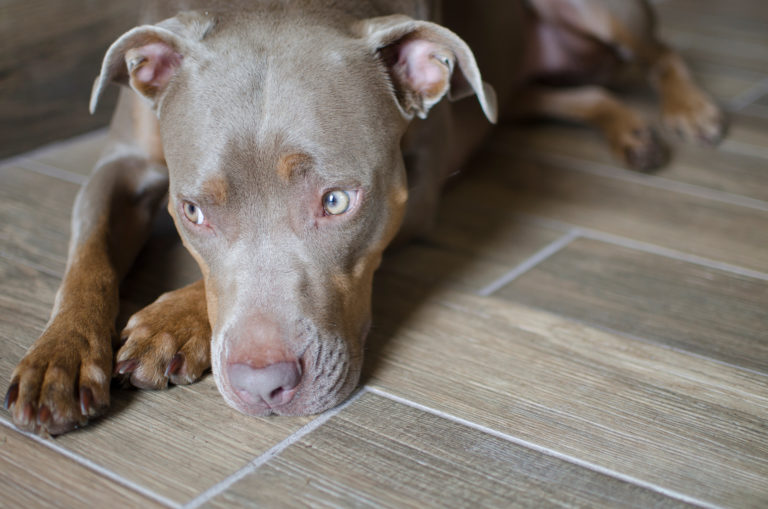

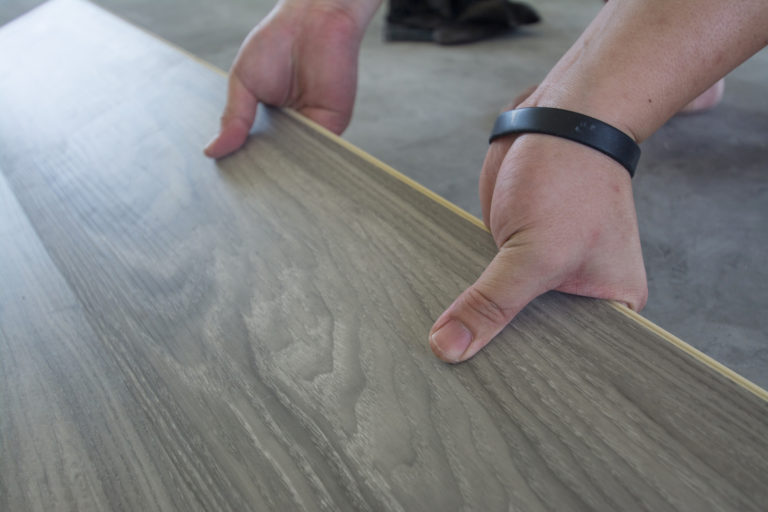

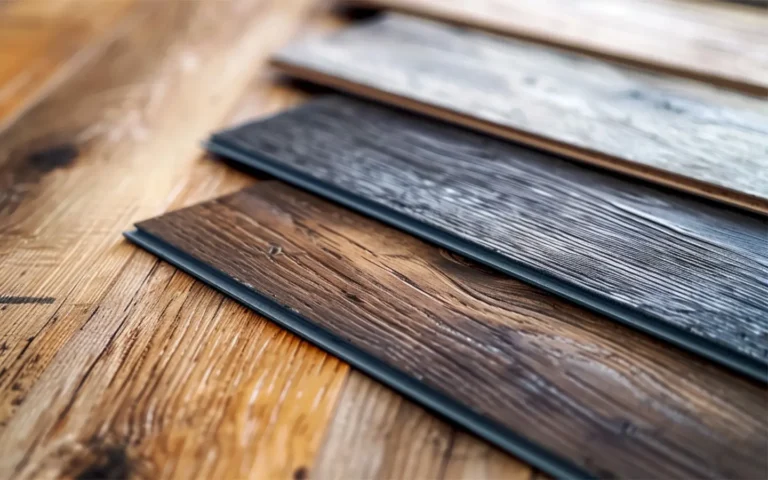

1 comment
Maria Pappano
Thanks so much for the great information here!